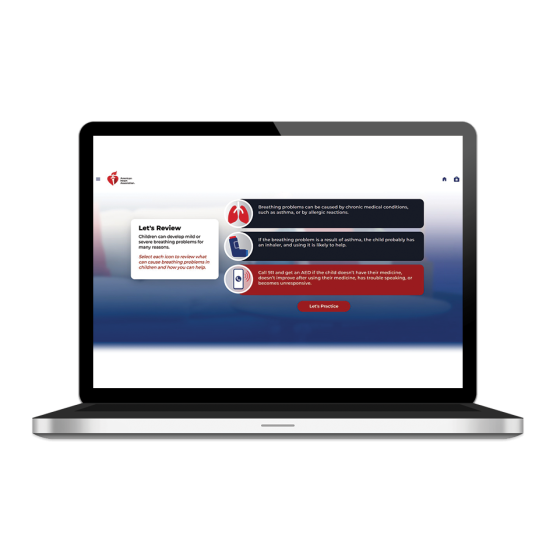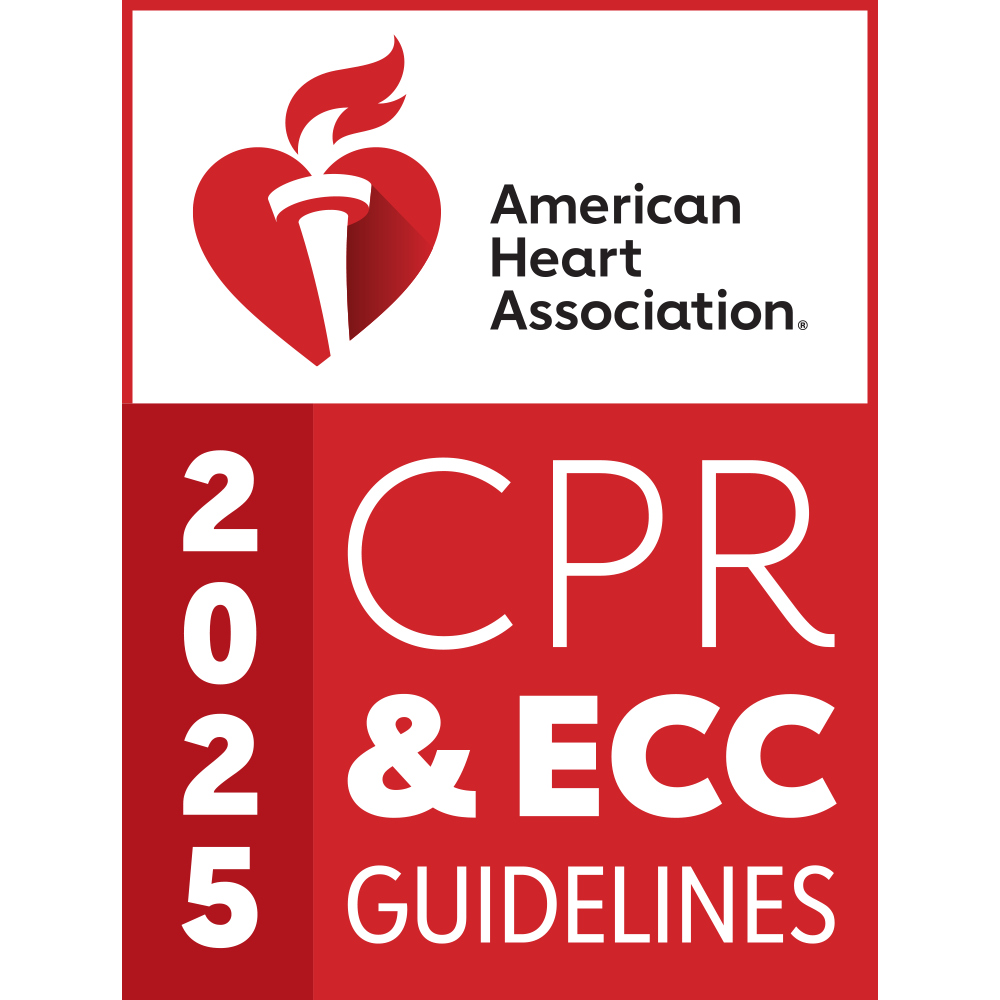Description
Learn lifesaving skills with Heartsaver Pediatric First Aid CPR AED Online.
The American Heart Association Heartsaver Pediatric First Aid CPR AED Online course provides high-quality training in first aid, CPR, and AED use. This course equips individuals and workplaces with the confidence to respond effectively to medical emergencies until emergency responders arrive. The online course format is a convenient way to learn at your own pace and schedule.
This blended learning course is designed for anyone with little or no medical training who needs first aid & CPR AED training and a course completion card for job, regulatory (e.g., OSHA), or other requirements. The course is intended for those involved in childcare who have a duty to respond to illnesses and injuries in a child or infant in the first few minutes until professional help arrives. It is also ideal for anyone who wants to be prepared to respond effectively to emergencies at work, home, or in the community.
What will you learn with the course?
• Child and Infant CPR and AED use
• Pediatric first aid basics
• Pediatric medical emergencies (including choking)
• Pediatric Injury emergencies
• Environmental emergencies
• Preventing illness and injury
• Opioid-associated life-threatening emergencies and how to use Nalaxone
• Optional modules in Adult CPR AED
Course Features & Benefits:
• Flexibility to learn anytime, anywhere
• Interactive activities reinforcing lifesaving techniques
• Engaging videos and real-life demonstrations
• Knowledge checks to ensure mastery
• Builds confidence and skills needed to take action
• Up-to-date medical science information
• High quality training from the American Heart Association
Course Format:
• Heartsaver Pediatric First Aid CPR AED Online is the required online course for the American Heart Association blended learning training.
• The blended learning format allows students to complete the online course at their convenience, followed by a hands-on skills session (sold separately) with an American Heart Association Training Center Instructor.
• Upon successful completion, students receive a Heartsaver Pediatric First Aid CPR AED Course Completion Card, valid for two years.
This product has been updated to reflect the latest science and education from the 2025 Guidelines for CPR & ECC. It replaces Heartsaver® Basic - First Aid CPR AED Online (20-1404).
Technical Requirements
Please refer to elearning.heart.org for specific course technical requirements.
Product Specifications
- Associated Course : Heartsaver Pediatric
- Format : Online Course
- Product Type : Blended and eLearning
Continuing Education Information
Heartsaver® Pediatric First Aid CPR AED Online
Original Release Date: 10/22/2025
Last Review Date: September 2025
Termination Date: 10/21/2028
Description
Heartsaver® Pediatric First Aid CPR AED Online is a self-directed course that provides the highest quality training in the lifesaving skills of first aid, CPR, and how to use an AED. The course is intended for those involved in childcare who must be prepared to respond to illnesses and injuries in a child or infant in the first few minutes until professional help arrives.
Learning Objectives
At the conclusion, participants should be able to:
1. Demonstrate how to assess the scene in an emergency
2. Describe how CPR improves survival
3. Explain the concepts of the Chain of Survival
4. Recognize when someone needs CPR
5. Perform CPR for a child, an infant, and an adult
6. Describe how to perform CPR with help from others
7. Demonstrate giving effective breaths by using mouth-to-mouth or a mask for all age groups
8. Describe how to use an AED on a child and an infant
9. Demonstrate using an AED on an adult
10. Describe when and how to help a choking child, infant, and adult
11. Discuss how to help someone experiencing an opioid-associated emergency
12. Recognize the techniques that help prevent drowning emergencies
13. Discuss initial actions to take when helping a child or person who has drowned
14. Discuss how universal precautions, personal protective equipment, and handwashing can protect against germs and disease
15. List the priorities, roles, and responsibilities of first aid rescuers
16. Describe the key steps in pediatric first aid
17. Describe the steps to remove protective gloves
18. Demonstrate the steps to respond to a pediatric first aid emergency
19. Describe the assessment and first aid actions for the following life-threatening conditions: difficulty breathing, choking, heat-related injuries (dehydration), severe bleeding, pediatric shock, and diabetes and low blood sugar
20. Describe how to use an epinephrine autoinjector
21. Demonstrate how to control bleeding and apply direct pressure and a bandage
22. Recognize elements of common pediatric illnesses and injuries
Accreditation Terms
IACET: 10/21/2025 – 10/21/2028
Joint Accreditation: N/A
CAPCE: N/A
AARC: N/A
Accreditation Statement
Continuing Education Accreditation – General Audience
The American Heart Association is accredited by the International Association for Continuing Education and Training (IACET). The American Heart Association complies with the ANSI/IACET Standard, which is recognized internationally as a standard of excellence in instructional practices. As a result of this accreditation, the American Heart Association is authorized to issue the IACET 0.30 CEU.
Participation and Successful Completion
Successful completion of this CE activity includes the following:
1. Complete all portions of the online activity
2. Complete the course evaluation
3. Print the Certificate/Statement of Credit
Disclosure Statement
All persons in a position to control educational content of a CE activity provided by the American Heart Association must disclose to the audience all financial relationships with ineligible companies whose primary business is producing, marketing, selling, re-selling, or distributing healthcare products used by or on patients. The presence or absence of all financial relationships will be disclosed to the audience in activity materials. All unlabeled/unapproved uses of drugs or devices discussed will also be disclosed to the audience. All relevant financial relationships have been mitigated prior to the commencement of the activity.
The following authors/faculty have declared NO financial interest(s) and/or affiliations:
Mark Terry, MPA, NRP
Jeanette Previdi, MPH, BSN, RN
Matthew Douma, RN, MN, ENC(C), CCN(C)
Jonathan Greene, EdS, MBA, BSN, RN, NRP, BSOM, CHSE, CMHE
Fabián Gelpi, MD
Denis Cristian Toledo Corrêa, PT, RRT
Gino Mollica, MA, NRP
Liz McKnight, CHES
Sylvia Molina
Comilla Sasson, MD, PhD, FAHA, FACEP
Jaylen Wright, PhD
Nekeisha Harrison, RN
Alyson Elliott
This list represents the relationships that may be perceived as actual or reasonable conflicts of interest as reported on the Disclosure Questionnaire, which all AHA volunteers are required to complete and submit. The focus is on relevant financial relationships with commercial interests in the 24-month period preceding the time that the individual is being asked to assume a role controlling content:
Anthony Lagina, MD, FACEP — Phenomics Labs (Medical Consultant)
Target Audiences
1. IACET
Accessibility Statement
The American Heart Association and American Stroke Association strive to make our websites accessible. The American Heart Association and American Stroke Association are committed to diversity, inclusion, and meeting the needs of all our constituents, including those with disabilities. We are continually improving our digital assets to comply with the accessibility guidelines for levels A and AA in accordance with WCAG 2.1.
If the format of any material on our web pages interferes with your ability to access the information, please contact us to request assistance or if you have questions or comments about our web sites’ accessibility.
Audience
Heartsaver Pediatric First Aid CPR AED is intended for those involved in childcare who have a duty to respond to illnesses and injuries in a child or infant in the first few minutes until professional help arrives. This audience includes childcare workers, teachers, foster care workers, camp counselors, youth organizations, and coaches for children’s sports organizations. This course is also ideal for parents, grandparents, extended family, babysitters, and guardians.











